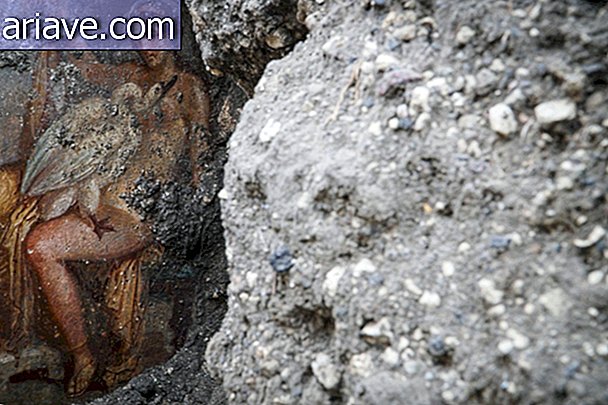5 legends created by men to explain natural phenomena
Humanity has not always understood the motives and processes of nature and its phenomena. Today, for example, we already know that lightning is caused by static electricity generated by the friction of countless particles of water and ice in a cloud. This process of knowledge, however, took thousands of years to happen (and is still happening in many areas).
Before the introduction of scientific reasoning, answers to some questions like "what produces lightning?" they were found only in mythology and legends. Check below five examples of stories and short stories that tried to explain the forces of nature.
5. Tsunami, the spirit of the sea

Source: Press Release / Pixabay.
For the Moken, a people living on some islands off the shores of Myanmar and Thailand, the tsunamis are caused by Katoy Oken, a sea spirit who sends "monstrous waves" to purify people spiritually and physically.
Legend has it that people felt the earth shake, knocking coconuts from the trees. They knew this was the wave awakened and sent by Katoy Oken. They gathered the fallen coconuts and went to sea hoping that the fury of the spirit would go to the island and ignore the boats. But the boats were slightly pushed and a village elder called his people to look at the beach. The water was gone. What followed was a wave that reached as high as the tops of the coconut trees. Katoy Oken's wave had cleansed the island, but no moken died.
The story has been passed from generation to generation for hundreds of years. In 2004, an 8.9 magnitude earthquake on the Richter Scale triggered a tsunami that hit several countries, killing 175, 000 people in the region and 125, 000 missing people. An island of about 200 mokens was on the wave route. When they saw the water recede from the beach, they immediately fled to higher ground. Only one of the 200 mokens died in the 2004 tsunami.
4. The earthquakes and the giant catfish

Source: Press Release / Pixabay.
In Japanese mythology, Namazu is a huge catfish that causes earthquakes with its tail. Originally, it was seen as a premonition, warning people before a flood or heavy rain or other harmful event. But over time, they became one of the Yo-kai, a creature of misfortune and disaster. Namazu is often said to be contained by the god Kashima under a colossal cornerstone, but Kashima is not always careful about his duties or tired and Namazu is able to wag his tail. Its uncontrolled tail causes earthquakes and tsunamis. Namazu was also known as a punishment for human greed. Their earthquakes destroyed the properties of the rich, forcing a redistribution of wealth.
3. Pachamama, the Avenging Mother

Source: Press Release / Pixabay.
In the countries of Colombia, Venezuela, Ecuador, Peru and Bolivia live an indigenous people who reverence Mother Earth or Pachamama. In ancient Inca mythology, she is a fertility goddess, a personification of nature that helps nurture and protect animals and plants. In the past, offerings to her included animal and even human sacrifices, but current offerings are generally limited to dry fetuses of buried llama, rice or peanuts.
Although known as a very kind and laid-back character, Pachamama is also responsible for the earthquakes, landslides and lightning she employs in her anger. They are aimed at those who do not take care of the earth or its creatures in a kind way. This vengeful side is reinforced by its frequent depiction as a dragon or a serpent.
2. Volcanoes arise from Kagutsuchi corpse

Source: Press Release / Pixabay.
Kagutsuchi, a god - or kami, as the deities of Shinto are called -, was born of the creator gods Izanami and Izanagi. However, like a fire kami, Kagutsuchi's birth killed his mother in an overwhelming flame and heat and she was sent to Yomi, the land of darkness. Izanagi was sad and went to Yomi to recover his dead wife, but when Izanagi found her, he found that Izanami was rotting and could never get out of there. She attacked her ex-husband and he ran away from Yomi. Once outside, he took revenge on his son who had stolen his wife by cutting Kagutsuchi to pieces. From Kagutshchi's body and the blood dripping from his father's sword, other gods appeared. Among them Takemikazuchi-no-kami and Futsunushi-no-kami, famous swordsmen, and Kuraokami-no-kami, a rain god. From eight pieces of his corpse emerged eight volcanoes that spew flame and heat, as Kagutsuchi did in life.
1. Death and disease

Source: Press Release / Pixabay.
Ancient Mesopotamia was polytheistic. Gods and humans were believed to work together to maintain the balance and harmony of the world. But if men and gods valued peace, why do humans suffer? As a way of explaining death and meaningless suffering, the people of the Babylonian city of Kutha invented a god who had an uncontrolled temperament called Nergal or Erra. Originally these names represented two different gods, but over time they became so closely linked that they began to refer to the same mythological figure. Nergal is a god of calamity that attacks senseless, just because of his bad temper. In his wrath, he was blamed for disease, plagues, and plagues as well as battlefield deaths.











